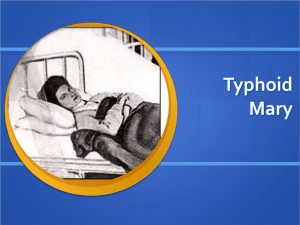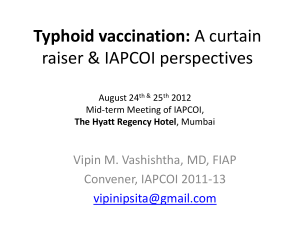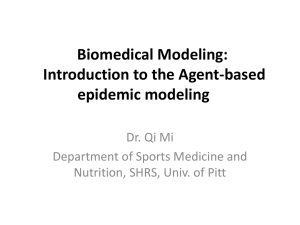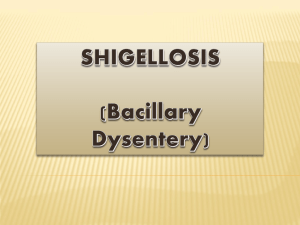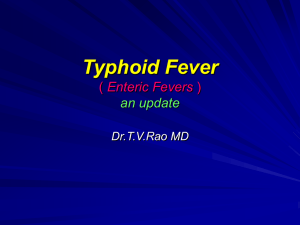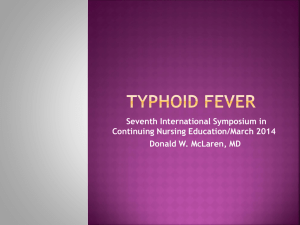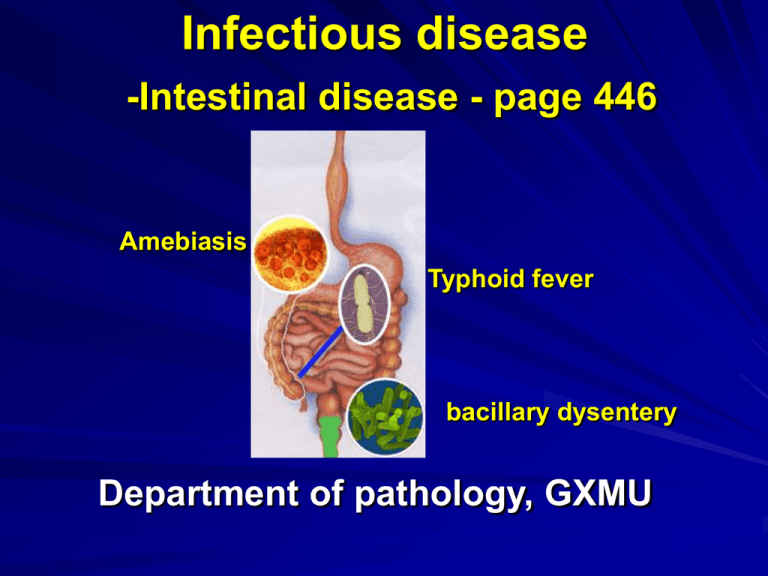
Infectious disease
-Intestinal disease - page 446
Amebiasis
Typhoid fever
bacillary dysentery
Department of pathology, GXMU
Introduction
Infectious source: patients & healthy carriers
Transmit Pattern: Fecal-oral route
Pathogen: bacilli or parasites
Key points
Inflammation type
Most common location
Intestinal ulcer
Diarrhea
Typhoid fever
公元3世纪之初期,张
仲景博览群书,广采众方,
凝聚毕生心血,写就《伤寒
杂病论》。伤寒,又谓,
“伤于寒邪”, 中医所说的
伤寒,广义上指的是外感热
病的总称,狭义指的是外感
风寒之邪,感而即发的疾病。
Typhoid fever- Introduction
Thomas Willis can be regarded as the
pioneer in typhoid fever. Until his classic
description in 1659 and its translation
into English in 1684, little had been
done to separate this disease from the
other disease with fever.
A systemic infection disease presenting
as continued fever with relative
badycardia ,and abdominal symptoms
and psychosis confusion.
Is characterized by involvement of
mononuclear phagocytic system (MPS),
with typhoid nodule formation,
especially in the Peyer’s patches and
solitary lymph follicles of lower ileum.
Epidemiology
High population
densities and poor sanitation
Distribution
Is still a very important problem in many developing countries
17 Million cases occur per year worldwide, 7 million distribute
in Asia, 4 million in Africa, 0.5 million in Latin America
Can be prevented by vanccine
Pathogen
Salmonella typhi (typhoid bacilli)
typhoid bacilli are rod-shape, 2-3um long and 0.4-
0.6 um in diameter
Three antigenic structures: O antigens; H
antigens; Vi antigens
Endotoxin
Widal reaction
flagellum
Transmission
Patients
Healthy carriers
(“Typhoid Mary” )
Fecal-oral
pattern
Flies
Tyhpoid Mary in the cartoons
Meet the ladies who drive heroes crazy. These are the women you
kill for, the women you die for.
Tyhpoid Mary in the movie
"Elektra"
Movie Photo
(Center) Natassia Malthe (Typhoid Mary) and Will Yun
Lee (Kirigi) in 20th Century Fox's "Elektra."
- A generic term for a carrier of a dangerous disease who
is a danger to public because they refuse to take
apporpriate precaution
Ingestion
Pathogenes
Invade the mucosa
Taken up by macrophages
and transported to regional
lymph node
Incubation period –
the first week
multiplies in lymphoid tissue
Bacteremia phase
Toxemia phase
Reinfects lymphoid tissue –
endotoxin and delayed
hypersensitivity reaction
Systemic illness – at the
end of the first week
Intestinal illness –
the second week
Pathological Changes
Typhoid Cells
Typhoid nodule (granuloma) formation
?
o It is a localized accumulation of
large mononuclear cells
o such as rheumatism,
tuberculosis
Typhoid cell
Erythrophagocytosis
Erythrophagocytosis
Typhoid cells and typhoid nodules (granuloma) is
hallmark histologic finding in typhoid fever
Typhoid nodule formation in the liver
Typhoid cells and typhoid nodules (granuloma) is
hallmark histologic finding in typhoid fever
Intestinal lesion
Lower ileum and cecum
4 stages (last 4 weeks)
Hyperplasis of Peyer’s pathes
Necrosis
Ulceration
Healing
Peyer’s patches:
a collection of lymphoid follicles
Locate in mucosa and extend into sumucosa
Terminal ileum contains most peyer’s patches
1st Stage (First week):
Hyperplasia of peyer’s pathes
The phagocytes in Peyer’s patches
of the ileum and the solitary lymph
follicles are proliferation and
Hyperplasia
Macroscopilly
Projected on the mucosal surface
Microscopilly
Typhoid granuloma with a large number
of typhoid cells can be seen obviously
Clinical
Blood culture † † † †
Stool culture -
2nd Stage(The second week) :
Necrosis
•Yellow or greenish-brown
•From center to peripheral
Clinical
Blood culture † † †
Stool culture
†
3rd Stage(The third week) :
Ulceration
Rounded or oval , deep ulcer,which long
axis is in the direction of the long axis of
the bowel (Longitudinal ulcer-typical
finding of typhoid by macroscopically).
Compare:
Transverse
Ulcer?
Clinical
Stool culture
†††
Widal reaction †††
4th Stage (The
fourth week):
Healing
Clinical
Widal reaction ††††
Extraintestinal Lesions
Phagocytes proliferate in Reticuloendothelial
system(网状内皮系统, mononuclear phagocytic
system )
Spleen (Sinus histiocytes) -Splenomegaly
Liver (Kupffer) - hepatomegaly
Lymph nodes
Bone marrow
The reaction tends to be similar everywhere, with proliferation
of large mononuclear cells and foci of necrosis
Clinical features
Bacteremia: blood culture / stool and urine culture
Toxemia : Disorientation, delirium(暂时精神
乱),Restleness,Headache , Rose spots,
Continued fever(稽留热) ,diarrhea ,Relative
Bradycardia
Splenomegaly and/or hepatomegaly
Leukopenia(白细胞少症状)
Complications
Hemorrhage
Perforation
Days
Stage
Rose spots
1st Stage
2nd Stage
3rd Stage
3th Stage
Splenomagly
Psychosis confusion
Leukopenia
Blood culture
Stool culture
Widal reaction
Continued fever(稽留热) and Relative Bradycardia: the classical type of
pyrexia with its step-ladder rise during the first week, its maintenance during
the second and third weeks, and its fall in the fourth week
rose spots: 2-4mm in diameter appear on the trunk
of patients;
Summary
1 Pathogen: Salmonella typhi
2 Inflammation: Granuloma
3 Pathological stages: Longitudinal ulcer
4 Clinical features: Continued fever, diarrhea,
relative badycardia , abdominal symptoms and
psychosis confusion
Bacillary dysentery
Introduction
is an acute infectious inflammatory
disease of the colon caused by
Shigella bacteria; characterized
by bloody mucoid diarrhea,
tenesmus(里急后重) and
abdominal pains. It commonly
occurs in summer and fall.
Etiology and pathogenesis
Four species of Shigella:
S.Flexneri 福氏
S.Sonnei (the most comon cause) 宋内氏
S.Boydii 鲍氏
S.Dysenteriae 志贺氏
-Minimal infective dose is less than 1000
organisms
Endotoxin
Patients
Healthy carriers
Fecal-oral route
Pathological changes and clinical types
Location: large intestine, sigmoid,
rectum(only involve the superficial layer)
Three types
Acute bacillary dysentery
Chronic bacillary dysentery
Toxic bacillary dysentery
Acute bacillary dysentery
congestion
Acute catarrhal inflammation
edema
infiltration
Acute pseudomembranous inflammation
pseudomembrane
(Fibrinous inflammation)
Lyse
fall off
Irregular,map-like,shallow ulcers
A pseudomembrane covered
on the mucosal surface ,
yellowish or yellow-greenish
in color
Plaques of yellow fibrin and inflammatory debris are
adherent to a reddened colon mucosa..
Bloody mucoid
Diarrhea?Tenesmus?
Pseudomembrane
Mucosa
Submucosa
The Pseudomembrane consist of a large deal of fibrin, necrotic epithelium,
neutruphils, RBC and bacteria. but the submucosa isn’t greatly involved.
Shallow, irregular, ragged
Map-like ulcers
Superficial scar formation
Stenosis ,hemorrhage
and perforation are
uncommon
Compare:
Transverse Ulcer
and longitudinal
ulcer
Passage of 10-40 stools
per day is usual,stools
compose of blood,mucus
and neutrophilics
Clinical features
Bloody mucoid diarrhea are more
commonly
Abdominal discomfort and tenesmus
Fever,headache,tireness and anorexia(食欲
减退)
May last 1 to 2 weeks
Chronic bacillary dysentery
•Transformed from acute bacillary dysentery.
•The clinical course exceed 2 monthes
•S.flexneri infection are more common
•Pseudomembrane,Ulcerations(new lesions) and
granulation tissue organization(old lesions) progress
repeatedly
•Polypi formation & stenosis of the bowel occur
•Bacillary culture from stool is persistent positive
Toxic bacillary dysentery
•2~7y children
•S.flexneri & S.sonnei infection
•Intestinal lesions are mild while general toxic
symptoms are severe
•Toxic shock & breath failure occur rapidly
Complications
•Bacteremia and septicemia (Malnourished
children)
•Hemolytic uremic syndrome (溶血性尿毒症综合
征)
•Central nervous system lesions
•Myocarditis
Summary
1 Pathogen: Shigella bacteria
2 Inflammation: Fibrinous inflammation
3 Pathological stages: Map-like ulcer
4 Clinical features: Bloody mucoid diarrhea and
tenesmus
Glossary-Bacillary dysentery
Amebiasis
阿米巴病
Entamoeba histolytica
溶组织阿米巴
amebic abscesse
阿米巴脓肿
Amebic dysentery
阿米巴痢疾
cysts
包囊
trophozoites
滋养体
Flask-shaped ulcers
烧瓶状溃疡
Amoeboma
阿米巴肿
Amebiasis
Introduction
Refers to the infection caused by Entamoeba
histolytica
Transmit: Fecal-oral route
May penetrate the mucosa and possibly invade
locally(Intestinal amebiasis) or by hematogenous
spread to other organs such as liver, lung, brain
and cause the organs of amebic abscesse
Human beings are the only known host of the
ameba
Epidemiology
Worldwide distribution
50 million new cases annually;
50 to 100 thousand deaths among them
Higher morbidity in rural area
Risk groups
Travelers, recent immigrants are most at risk
Intestinal amebiasis
An infection disease caused by E.
histolytica that inhabits the intestinal tract.
Fecal-Oral transmission
Diarrhea - -- Amebic dysentery
Low grade fever
Ingestion of cysts
intestinal alkaline medium
Encysted organism becomes
small trophozoites
Small trophozoites develop
adult trophozoites
Move to cecum
become a commensal or a
highly invasive pathogen
Lyse host
tissue
Become cysts
Etiology and pathogen
Pathogenesis of Amebiasis
Adult Trophozoites ...
Contact lyse by enzyme
or Enzymatic necrosis
•Attach to mucosal epithelial cells (MEC)
•Lyse MEC (contact-dependent cytolytic mechanism)
•Ulcerate and invade mucosa
•Cause dysentery
•spread to other organs via blood to cause a Amebic
abscesses in extraintestinal sites
Pathology
Location:
Most frequently in cecum,
less frequency in the ascending colon,
sigmoid, rectum, and appendix.
Ulcer formation:
Pinpoint-sized ulcers
Fastener-shaped ulcers
Flask-shaped ulcers
Large, undermined edges ulcers
Pinpoint-sized ulcers
mouth
mucosa
neck
bottom
submucosa
Flask-shaped ulcer
Flask-shaped ulcer
Amoebae are found in the base and at the margins of
ulcers, chiefly in the submucosa
some RBCs are phagocytized by the trophozoites
(erythrophagocytosis)
Trophozoite vascular invasion
Amoeboma (阿米巴肿):
- Chronic intestinal amebiasis
- Palpable mass,tumour-like of granulation tissue
that may obstruct colon.
-May be mistaken for carcinoma of colon in clinical
Extraintestinal amebiasis
-Amebic liver abscesses
The most frequent complication
Cause by the entry of amebic trophozoites via
portal vein
Focal enzymatic necrosis of
hepatoctyes(abscesses)
Abscesses are not true abscesses (neutrophil
leucocytes are absence)
Systemic spread of trophozoires,resulting in
amebic abscesses in the brain and lung
Liver ‘abscess’- no real pus
-May be Single or multiple, most
frequently right-sided
-Contain amebic ‘“ pus,” which
has the typical reddish- brown
hue (likened to anchovy paste果
酱样) of liquefied liver
-There are many residual bile
ducts and blood vessels within
the lesion. The lining is rough and
shaggy.
-There is a connective tissue wall
in older ‘abscesses’.
- Trophozoites of E. histolytica
may be found in the abscess
wall
The contents are
odorless, pasty,
semifluid, and
reddish- brown hue
(likened to anchovy
paste
Amebic lung abscesses
Direct extension of hepatic abscesses through the
diaphragm(横隔) into the right lobe of the lung;
may also arise via bloodstream
Summary
1 Pathogen: Entamoeba histolytica
2 Inflammation: Enzymatic necrosis
3 Flask-like ulcer
4 Clinical features: Low grade fever reddishbrown hue (likened to anchovy paste) diarrhea
Location
Inflammation
Ulcer
Clinical
Typhoid
Fever
Bacillary
Dysentery
Intestinal
Amebiasis
Lower ileum
and cecum
sigmoid, rectum
cecum
Typhoid
granuloma
Fibrinous pseudomenbran
e
Necrosis
Longitudinal
ulcer
Map-like ulcer
Flask-like ulcer
Continued fever,
diarrhea,
disorientation,
Bradycardiah
Bloody mucoid
diarrhea ,
tenesmus
reddish- brown
hue (likened to
anchovy paste)
diarrhea
How to prevent these intestinal infectious diseases?
Washing hands after going to the toilet, and before handling or eating food.
psychosis confusion, solitary lymph follicles , Paua New Guinea, bacilli, outbreak,
Salmonella typhi -typhoid bacilli, epidemic, Biliary bile
gallbladder,excrete,convey,contaminate,deny, refuse to cease,quarantine,
authority,born with this diease, Pregnancy,Ireland,died,seven of eight household
members, request,reject,investigate, concept of healthy carrier was not well known,
healthy inspector and police officer, Isolate,release on the condition she would not
work with food ,pseudonym,seize, inactivated by gastric acid, thoracic,
Mesenteric, swollen, hypersensitivity reaction, oval , Longitudinal Secondary intestinal
Tuberculosis,peripheral – preserve,elevate, granulation tissue, hepatomegaly,
Splenomegaly,Pulse, tenesmus. Shigella, stool mass, stool frequency, or stool
fluidity,species Sigmoid,rectum,diphtheria,superficial,mucus,mucoid, persistent
positive,sensible,severe, abdominal ,Malnourished, Amebiasis, Entamoeba histolytica,
trophozoites, Amoeboma Ameba, Parasitosis parasite,motile, Lyse, Palpable,
neutrophil leucocyte anchovy paste, sphincter ani –anal, nerve fiber, irritate
Feces, anus, sensitivity, suppress, compatible, serosa, peritonaeum, pyrexia,
hemolysis, renal failure, Rural, resistant/persistant/

